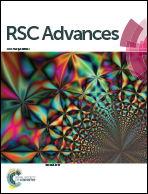Effect of calcination on adsorption performance of Mg–Al layered double hydroxide prepared by a water-in-oil microemulsion method
Abstract
Herein, Mg–Al layered double hydroxide (LDH) was firstly prepared by a water-in-oil microemulsion method and the prepared LDH sample was further calcined at different temperatures. The calcined LDH samples were carefully characterized using XRD, nitrogen adsorption, TEM, TGA, XPS, FTIR and zeta potential measurements. Calcined and uncalcined LDH samples were used as adsorbents to remove orange II (O-II) dye in water. Adsorption experiments indicated calcination temperatures had an obvious influence on the adsorption affinity of LDH, and the 500 °C calcined LDH sample (LDH-500) exhibited the maximum adsorption capacity of 602 mg g−1 larger than that of LDH (224 mg g−1). The pseudo-second-order model was the best kinetic model to describe O-II adsorbed on the surface of the adsorbent, and the dye adsorption was fitted well using the Langmuir model for the prepared samples. The adsorption mechanism of O-II dye onto the calcined and uncalcined LDHs samples was mainly related to electrostatic interaction between the anionic O-II molecules and positively charged surface of the adsorbents, and the slow intercalation of O-II into the layers of LDH and reconstruction of LDH-500.


 Please wait while we load your content...
Please wait while we load your content...